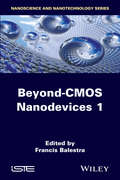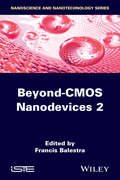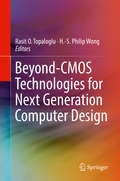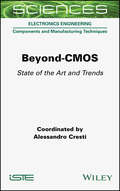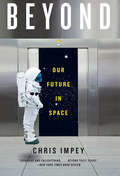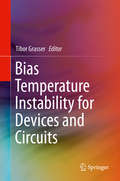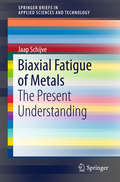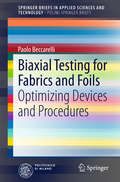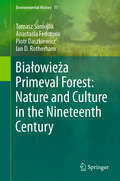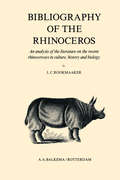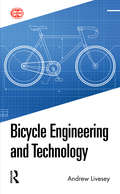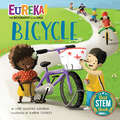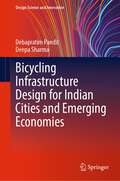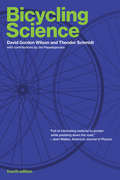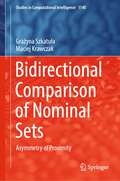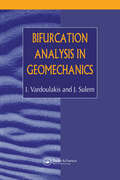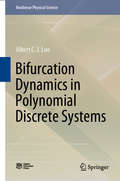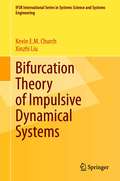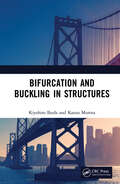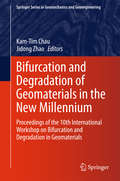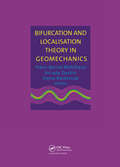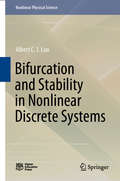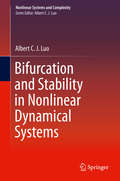- Table View
- List View
Beyond-CMOS Nanodevices 1
by Francis BalestraThis book offers a comprehensive review of the state-of-the-art in innovative Beyond-CMOS nanodevices for developing novel functionalities, logic and memories dedicated to researchers, engineers and students. It particularly focuses on the interest of nanostructures and nanodevices (nanowires, small slope switches, 2D layers, nanostructured materials, etc.) for advanced More than Moore (RF-nanosensors-energy harvesters, on-chip electronic cooling, etc.) and Beyond-CMOS logic and memories applications.
Beyond-CMOS Nanodevices 2
by Francis BalestraThis book offers a comprehensive review of the state-of-the-art in innovative Beyond-CMOS nanodevices for developing novel functionalities, logic and memories dedicated to researchers, engineers and students. The book will particularly focus on the interest of nanostructures and nanodevices (nanowires, small slope switches, 2D layers, nanostructured materials, etc.) for advanced More than Moore (RF-nanosensors-energy harvesters, on-chip electronic cooling, etc.) and Beyond-CMOS logic and memories applications.
Beyond-CMOS Technologies for Next Generation Computer Design
by Rasit O. Topaloglu H.-S. Philip WongThis book describes the bottleneck faced soon by designers of traditional CMOS devices, due to device scaling, power and energy consumption, and variability limitations. This book aims at bridging the gap between device technology and architecture/system design. Readers will learn about challenges and opportunities presented by “beyond-CMOS devices” and gain insight into how these might be leveraged to build energy-efficient electronic systems.
Beyond-CMOS: State of the Art and Trends
by Alessandro CrestiRecent advances in physics, material sciences and technology have allowed the rise of new paradigms with bright prospects for digital electronics, going beyond the reach of Moore's law, which details the scaling limit of electronic devices in terms of size and power. This book presents original and innovative topics in the field of beyond CMOS electronics, ranging from steep slope devices and molecular electronics to spintronics, valleytronics, superconductivity and optical chips. Written by globally recognized leading research experts, each chapter of this book will provide an introductory overview of their topic and illustrate the state of the art and future challenges. Aimed not only at students and those new to this field, but also at well-experienced researchers, Beyond-CMOS provides extremely clear and exciting perspectives about the technology of tomorrow, and is thus an effective tool for understanding and developing new ideas, materials and architectures.
Beyond: Our Future in Space
by Chris ImpeyBeyond dares to imagine a fantastic future for humans in space--and then reminds us that we're already there. Human exploration has been an unceasing engine of technological progress, from the first homo sapiens to leave our African cradle to a future in which mankind promises to settle another world. Beyond tells the epic story of humanity leaving home--and how humans will soon thrive in the vast universe beyond the earth. A dazzling and propulsive voyage through space and time, Beyond reveals how centuries of space explorers--from the earliest stargazers to today's cutting-edge researchers--all draw inspiration from an innate human emotion: wanderlust. This urge to explore led us to multiply around the globe, and it can be traced in our DNA. Today, the urge to discover manifests itself in jaw-dropping ways: plans for space elevators poised to replace rockets at a fraction of the cost; experiments in suspending and reanimating life for ultra-long-distance travel; prototypes for solar sails that coast through space on the momentum of microwaves released from the Earth. With these ventures, private companies and entrepreneurs have the potential to outpace NASA as the leaders in a new space race. Combining expert knowledge of astronomy and avant-garde technology, Chris Impey guides us through the heady possibilities for the next century of exploration. In twenty years, a vibrant commercial space industry will be operating. In thirty years, there will be small but viable colonies on the Moon and Mars. In fifty years, mining technology will have advanced enough to harvest resources from asteroids. In a hundred years, a cohort of humans born off-Earth will come of age without ever visiting humanity's home planet. This is not the stuff of science fiction but rather the logical extension of already available technologies. Beyond shows that space exploration is not just the domain of technocrats, but the birthright of everyone and the destiny of generations to come. To continue exploration is to ensure our survival. Outer space, a limitless unknown, awaits us.
Bhartiya Samajatil Sanskrutik Prashna Six Semester TYBA New NEP Syllabus - RTMNU: भारतीय समाजातील सांस्कृतिक प्रश्न सहावे सत्र टी.वाय.बी.ए. नवीन एन.इ.पी. अभ्यासक्रम - राष्ट्रसंत तुकडोजी महाराज नागपूर विद्यापीठ
by Dr Rahul Bhagat Dr Nalini Borkar'भारतीय समाजातील सांस्कृतिक प्रश्न' हे पुस्तक डॉ. राहुल भगत आणि डॉ. नलिनी बोरकर यांचे महत्त्वपूर्ण संशोधनपर कार्य असून, समाजशास्त्राच्या अभ्यासक्रमानुसार भारतीय समाजातील सांस्कृतिक विविधतेचा व्यापक आढावा घेते. या ग्रंथात बहुसांस्कृतिकता, लिंग आणि पितृसत्ता, माध्यमे व जागतिकीकरण, तसेच सांस्कृतिक संघर्ष यांसारख्या मुद्द्यांचा सखोल अभ्यास केला आहे. भारतीय समाजाची वैशिष्ट्ये म्हणजे अनेक धर्म, जाती, भाषा, आणि प्रांतांची एकत्रित सहअस्तित्वाची संस्कृती. पुस्तकात विविध अन्न, पोशाख, सण, प्रथा-परंपरा, आणि धार्मिक आचार यांच्यातील विविधता स्पष्ट करून, त्यातून उद्भवणाऱ्या संघर्षांचा मागोवा घेतला आहे. विशेषतः आस्तिकता-नास्तिकता, जातिविरोधी पंथ, नारायण गुरु व पेरियार यांचे कार्य, आणि बौद्ध धर्माचे महत्त्व यावर विस्तृत चर्चा आहे. पितृसत्ताक रचनेतील स्त्रियांची स्थिती, LGBTQ+ च्या समस्या, आणि स्त्री हक्क यावर सुद्धा पुस्तक सखोल विचार मांडते. जागतिकीकरणामुळे भारतीय संस्कृतीवर झालेले परिणाम, पाश्चिमात्यीकरण, सांस्कृतिक संकरीकरण, आणि स्थानिकतेचे महत्त्व हे भागही महत्त्वाचे आहेत. सांस्कृतिक संघर्षांच्या मुळाशी असलेल्या जातीय, धार्मिक, वांशिक, व प्रादेशिक संघर्षांवरही या पुस्तकात चर्चा आहे. बहुसंख्याक आणि अल्पसंख्याक संस्कृतीमधील अंतर, आदिवासी संस्कृतीचे संरक्षण, आणि भारतातील सांस्कृतिक परिवर्तनाची प्रक्रिया अत्यंत सुबोध पद्धतीने मांडण्यात आली आहे. एकूणच, हे पुस्तक भारतीय समाजातील सांस्कृतिक गुंतागुंतीचे वास्तव आणि त्यातील समस्यांचा अभ्यासू दृष्टिकोनातून वेध घेते.
Bias Temperature Instability for Devices and Circuits
by Tibor GrasserThis book provides a single-source reference to one of the more challenging reliability issues plaguing modern semiconductor technologies, negative bias temperature instability. Readers will benefit from state-of-the art coverage of research in topics such as time dependent defect spectroscopy, anomalous defect behavior, stochastic modeling with additional metastable states, multiphonon theory, compact modeling with RC ladders and implications on device reliability and lifetime.
Biaxial Fatigue of Metals: The Present Understanding (SpringerBriefs in Applied Sciences and Technology #0)
by Jaap SchijveProblems of fatigue under multiaxial fatigue loads have been addressed in a very large number of research publications. The present publication is primarily a survey of biaxial fatigue under constant amplitude loading on metal specimens. It starts with the physical understanding of the fatigue phenomenon under biaxial fatigue loads. Various types of proportional and non-proportional biaxial fatigue loads and biaxial stress distributions in a material are specified. Attention is paid to the fatigue limit, crack nucleation, initial micro crack growth and subsequent macro-crack in different modes of crack growth. The interference between the upper and lower surfaces of a fatigue crack is discussed. Possibilities for predictions of biaxial fatigue properties are analysed with reference to the similarity concept. The significance of the present understanding for structural design problems is considered. The book is completed with a summary of major observations.
Biaxial Testing for Fabrics and Foils: Optimizing Devices and Procedures (SpringerBriefs in Applied Sciences and Technology)
by Paolo BeccarelliThis book offers a well-structured, critical review of current design practice for tensioned membrane structures, including a detailed analysis of the experimental data required and critical issues relating to the lack of a set of design codes and testing procedures. The technical requirements for biaxial testing equipment are analyzed in detail, and aspects that need to be considered when developing biaxial testing procedures are emphasized. The analysis is supported by the results of a round-robin exercise comparing biaxial testing machines that involved four of the main research laboratories in the field. The biaxial testing devices and procedures presently used in Europe are extensively discussed, and information is provided on the design and implementation of a biaxial testing rig for architectural fabrics at Politecnico di Milano, which represents a benchmark in the field. The significance of the most recent developments in biaxial testing is also explored.
Białowieża Primeval Forest: Nature and Culture in the Nineteenth Century (Environmental History #11)
by Tomasz Samojlik Ian D. Rotherham Anastasia Fedotova Piotr DaszkiewiczUnderstanding the current state and dynamics of any forest is extremely difficult - if not impossible - without recognizing its history. Białowieża Primeval Forest (BPF), located on the border between Poland and Belarus, is one of the best preserved European lowland forests and a subject of myriads of works focusing on countless aspects of its biology, ecology, management. BPF was protected for centuries (15th-18th century) as a game reserve of Polish kings and Lithuanian grand dukes. Being, at that time, a part of the Grand Duchy of Lithuania, BPF was subject to long-lasting traditional, multi-functional utilisation characteristic for this part of Europe, including haymaking on forest meadows, traditional bee-keeping and fishing in rivers flowing through forest. This traditional model of management came to an abrupt end due to political change in 1795, when Poland and Grand Duchy of Lithuania ceased to exist in effect of partitioning by neighbouring countries, and the territory of BPF was taken over by the Russian Empire. The new Russian administration, influenced by the German trends in forestry, attempted at introducing the new, science-based forestry model in the BPF throughout the 19th century. The entire 19th century in the history of BPF is a story of struggle between new trends and concepts brought and implemented by new rulers of the land, and the traditional perception of the forest and forest uses, culturally rooted in this area and originating from mediaeval (or older) practices.The book will show the historical background and the outcome of this struggle: the forest’s history in the long 19th century focusing on tracking all cultural imprints, both material (artificial landscapes, introduced alien species, human-induced processes) and immaterial (traditional knowledge of forest and use of forest resources, the political and cultural significance of the forest) that shaped the forest’s current state and picture. Our book will deliver a picture of a crucial moment in forest history, relevant not only to the Central Europe, but to the continent in general. Moment of transition between a royal hunting ground, traditional type of use widespread throughout Europe, to a modern, managed forest. Looking at main obstacles in the management shift, the essential difference in perceptions of the forest and goods it provides in both modes of management, and the implications of the management change for the state of BPF in the long 19th century could help in better understanding the changes that European forests underwent in general.
Bibliography of the Rhinoceros
by L.C. RookmaakerA listing and analysis of 3106 references to the rhinoceros in books and articles.
Bicycle Engineering and Technology
by Andrew LiveseyBicycle Engineering and Technology is a primer and technical introduction for anyone interested in bicycles, bicycling and the bicycle industry. With insight into how bicycles are made and operated, the book covers the engineering materials used for their manufacture and the technicalities of riding. It also discusses ways in which the enthusiast may wish to get involved in the business of working with these fantastic machines, which are now being aided with electrical power. The bicycle is a significant factor in transportation around the world and is playing an increasingly crucial role in transport policy as we collectively become more environmentally conscious. To celebrate the importance of the bicycle on the world stage, a brief history is included along with a detailed timeline showing the development of the bicycle with major world events. Previous knowledge of engineering or technology is not required to enjoy this text, as all technical terms are explained and a full glossary and lists of abbreviations are included. Whether you are a bicycling enthusiast, racer, student or bicycle professional, you will surely want to read it and keep it on your shelf as a handy reference.
Bicycle: Eureka! The Biography of an Idea (Eureka! The Biography of an Idea)
by Lori Haskins HouranWho likes bikes? Just about everyone! Here is a "biography" of bicycles, an essential invention that keeps people rolling!From the first spark of an idea of a new way to get around to the spread of bicycles throughout the world, Bicycle is a fun and informative look at an invention that makes a huge difference in our lives. This STEAM nonfiction title is part of the new Eureka! series with each book focusing on one groundbreaking, world-changing discovery that millions of people use every single day.
Bicycling Infrastructure Design for Indian Cities and Emerging Economies (Design Science and Innovation)
by Debapratim Pandit Deepa SharmaThe book focuses on specific infrastructural solutions for bicycling for Indian cities and other emerging economies. It explores the current state of bicycling infrastructure in Indian cities and proposes standard and custom designs, guidelines, 2D and 3D illustrations, technical drawings as well as relevant discussions and explanations for the choice of right infrastructural solutions according to site constraints. This volume will be of great interest to those in academia and industry dedicated to a vision of creating inclusive streets in Indian cities and emerging economies to making the street safe and comfortable for bicyclists.
Bicycling Science, fourth edition (The\mit Press Ser.)
by David Gordon Wilson Theodor SchmidtAn updated edition of a classic: an indispensable companion for a new era in cycling.The bicycle is almost unique among human-powered machines in that it uses human muscles in a near-optimum way. This essential volume offers a comprehensive account of the history of bicycles, how human beings propel them, what makes them go faster—and what keeps them from going even faster. Over the years, and through three previous editions, Bicycling Science has become the bible of technical bicycling not only for designers and builders of bicycles but also for cycling enthusiasts.After a brief history of bicycles and bicycling that demolishes many widespread myths, this fourth edition covers recent experiments and research on human-powered transportation, with updated material on cycling achievements, human-powered machines for use on land and in air and water, power-assisted bicycles, and human physiology. The authors have also added new information on aerodynamics, rolling drag, transmission of power from rider to wheels, braking, heat management, steering and stability, power and speed, and other topics. This edition also includes many new references and figures.With racks of bikeshare bikes on city sidewalks, and new restrictions on greenhouse gas–emitting cars, bicycle use will only grow. This book is the indispensable companion for a new era in cycling.
Bidirectional Comparison of Nominal Sets: Asymmetry of Proximity (Studies in Computational Intelligence #1140)
by Maciej Krawczak Grażyna SzkatułaThe authors propose a novel measure of proximity between two sets of nominal elements. This measure describes the changes in the first set after adding the second set or changes in the second set after adding the first set.It is crucial to note that this measure is not symmetric, it means that the perturbation of the first set on the second set can be different than the perturbation of the opposition direction. The introduced set impact measure allows for the direct treatment of objects described by nominal-valued attributes. The ordinary sets, multisets, fuzzy sets, and the intuitionistic fuzzy sets are considered. The book is intended for data science professionals, philosophers as well as cognitive psychologists, who struggle with practical problems in which asymmetry of proximity of objects cannot be neglected. The use of the proposed measures of perturbation between compared objects can be very important in data mining or in exploration of Internetresources.
Bifurcation Analysis in Geomechanics
by J. Sulem I.G. VardoulakisThis book examines the experimental and theoretical aspects of bifurcation analysis as applied to geomechanics. Coverage includes basic continuum mechanics for dry and fluid unfiltrated porous media, bifurcation and stability analyses applied to layered geological media and granular materials, and theories for generalized continua as applied to materals.
Bifurcation Dynamics in Polynomial Discrete Systems (Nonlinear Physical Science)
by Albert C. LuoThis is the first book focusing on bifurcation dynamics in 1-dimensional polynomial nonlinear discrete systems. It comprehensively discusses the general mathematical conditions of bifurcations in polynomial nonlinear discrete systems, as well as appearing and switching bifurcations for simple and higher-order singularity period-1 fixed-points in the 1-dimensional polynomial discrete systems. Further, it analyzes the bifurcation trees of period-1 to chaos generated by period-doubling, and monotonic saddle-node bifurcations. Lastly, the book presents methods for period-2 and period-doubling renormalization for polynomial discrete systems, and describes the appearing mechanism and period-doublization of period-n fixed-points on bifurcation trees for the first time, offering readers fascinating insights into recent research results in nonlinear discrete systems.
Bifurcation Theory of Impulsive Dynamical Systems (IFSR International Series in Systems Science and Systems Engineering #34)
by Xinzhi Liu Kevin E.M. ChurchThis monograph presents the most recent progress in bifurcation theory of impulsive dynamical systems with time delays and other functional dependence. It covers not only smooth local bifurcations, but also some non-smooth bifurcation phenomena that are unique to impulsive dynamical systems. The monograph is split into four distinct parts, independently addressing both finite and infinite-dimensional dynamical systems before discussing their applications. The primary contributions are a rigorous nonautonomous dynamical systems framework and analysis of nonlinear systems, stability, and invariant manifold theory. Special attention is paid to the centre manifold and associated reduction principle, as these are essential to the local bifurcation theory. Specifying to periodic systems, the Floquet theory is extended to impulsive functional differential equations, and this permits an exploration of the impulsive analogues of saddle-node, transcritical, pitchfork and Hopf bifurcations.Readers will learn how techniques of classical bifurcation theory extend to impulsive functional differential equations and, as a special case, impulsive differential equations without delays. They will learn about stability for fixed points, periodic orbits and complete bounded trajectories, and how the linearization of the dynamical system allows for a suitable definition of hyperbolicity. They will see how to complete a centre manifold reduction and analyze a bifurcation at a nonhyperbolic steady state.
Bifurcation and Buckling in Structures
by Kiyohiro Ikeda Kazuo MurotaBifurcation and Buckling in Structures describes the theory and analysis of bifurcation and buckling in structures. Emphasis is placed on a general procedure for solving nonlinear governing equations and an analysis procedure related to the finite-element method. Simple structural examples using trusses, columns, and frames illustrate the principles. Part I presents fundamental issues such as the general mathematical framework for bifurcation and buckling, procedures for the buckling load/mode analyses, and numerical analysis procedures to trace the solution curves and switch to bifurcation solutions. Advanced topics include asymptotic theory of bifurcation and bifurcation theory of symmetric systems. Part II deals with buckling of perfect and imperfect structures. An overview of the member buckling of columns and beams is provided, followed by the buckling analysis of truss and frame structures. The worst and random imperfections are studied as advanced topics. An extensive review of the history of buckling is presented. This text is ideal for advanced undergraduate and graduate students in engineering and applied mathematics. To assist readers, problems are listed at the end of each chapter, and their answers are given at the end of the book. Kiyohiro Ikeda is Professor Emeritus at Tohoku University, Japan. Kazuo Murota is a Project Professor at the Institute of Statistical Mathematics, Japan, as well as Professor Emeritus at the University of Tokyo, Kyoto University, and Tokyo Metropolitan University, Japan.
Bifurcation and Degradation of Geomaterials in the New Millennium: Proceedings of the 10th International Workshop on Bifurcation and Degradation in Geomaterials (Springer Series in Geomechanics and Geoengineering)
by Kam-Tim Chau Jidong ZhaoThis book contains contributions to the 10th International Workshop on Bifurcation and Degradation in Geomaterials held in Hong Kong, May 28-30, 2014. This event marks the silver Jubilee anniversary of an international conference series dedicated to the research on localization, instability, degradation and failure of geomaterials since 1988 when its first workshop was organized in Germany. This volume of book collects the latest progresses and state-of-the-art research from top researchers around the world, and covers topics including multiscale modeling, experimental characterization and theoretical analysis of various instability and degradation phenomena in geomaterials as well as their relevance to contemporary issues in engineering practice. This book can be used as a useful reference for research students, academics and practicing engineers who are interested in the instability and degradation problems in geomechanics and geotechnical engineering.
Bifurcation and Localisation Theory in Geomechanics
by Hans-Bernd Mühlhaus; Arcady V. Dyskin; Elena PasternakThis work contains proceedings of a workshop on Bifurcation and Localisation Theory in Geomechanics, held in Perth, Australia in 1999. It covers a range of themes from classic civil engineering subjects to non-linear and non-unique geological phenomena.
Bifurcation and Stability in Nonlinear Discrete Systems (Nonlinear Physical Science)
by Albert C. LuoThis book focuses on bifurcation and stability in nonlinear discrete systems, including monotonic and oscillatory stability. It presents the local monotonic and oscillatory stability and bifurcation of period-1 fixed-points on a specific eigenvector direction, and discusses the corresponding higher-order singularity of fixed-points. Further, it explores the global analysis of monotonic and oscillatory stability of fixed-points in 1-dimensional discrete systems through 1-dimensional polynomial discrete systems. Based on the Yin-Yang theory of nonlinear discrete systems, the book also addresses the dynamics of forward and backward nonlinear discrete systems, and the existence conditions of fixed-points in said systems. Lastly, in the context of local analysis, it describes the normal forms of nonlinear discrete systems and infinite-fixed-point discrete systems. Examining nonlinear discrete systems from various perspectives, the book helps readers gain a better understanding of the nonlinear dynamics of such systems.
Bifurcation and Stability in Nonlinear Dynamical Systems (Nonlinear Systems and Complexity #28)
by Albert C. LuoThis book systematically presents a fundamental theory for the local analysis of bifurcation and stability of equilibriums in nonlinear dynamical systems. Until now, one does not have any efficient way to investigate stability and bifurcation of dynamical systems with higher-order singularity equilibriums. For instance, infinite-equilibrium dynamical systems have higher-order singularity, which dramatically changes dynamical behaviors and possesses the similar characteristics of discontinuous dynamical systems. The stability and bifurcation of equilibriums on the specific eigenvector are presented, and the spiral stability and Hopf bifurcation of equilibriums in nonlinear systems are presented through the Fourier series transformation. The bifurcation and stability of higher-order singularity equilibriums are presented through the (2m)th and (2m+1)th -degree polynomial systems. From local analysis, dynamics of infinite-equilibrium systems is discussed. The research on infinite-equilibrium systems will bring us to the new era of dynamical systems and control. Presents an efficient way to investigate stability and bifurcation of dynamical systems with higher-order singularity equilibriums;Discusses dynamics of infinite-equilibrium systems;Demonstrates higher-order singularity.
Big Bertha's Big Trip (Fountas & Pinnell Classroom, Guided Reading)
by Alice CaryNIMAC-sourced textbook. BIG PLANS FOR A BIG CRUISER. The huge red machine was called the Snow Cruiser, and no one had ever seen anything like it. It was built to travel over ice in Antarctica. But how would it get to the bottom of the world?
